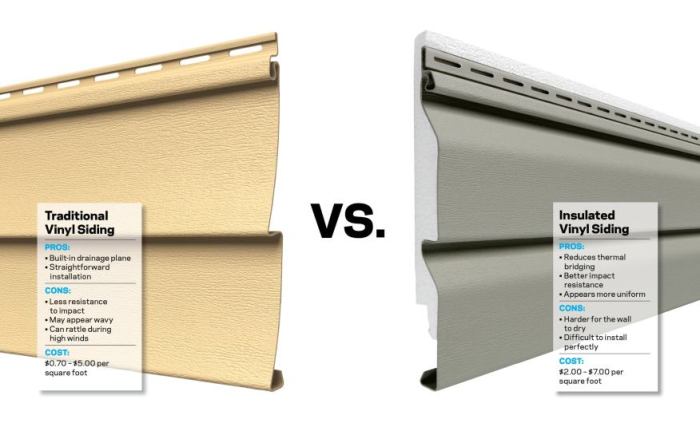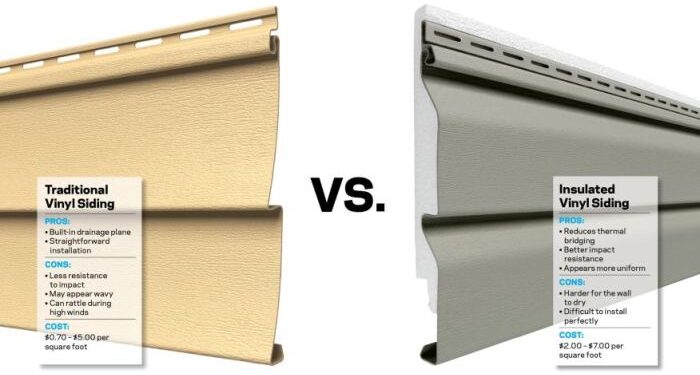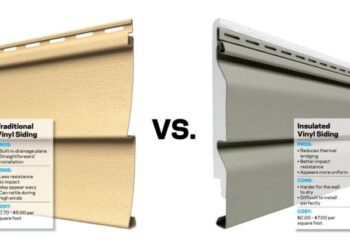As we delve into the realm of insulated vinyl siding cost, a world of possibilities opens up. From understanding the factors that drive costs to comparing different materials, this topic promises to shed light on a crucial aspect of home improvement.
Let's uncover the nuances of pricing, installation complexities, and regional influences that shape the cost dynamics of insulated vinyl siding.

.." width="700" height="427" />
When it comes to the cost of insulated vinyl siding, regional variations play a significant role in determining the final price. Factors such as location, climate conditions, and labor costs can all impact how much you will pay for your siding installation.
Factors Affecting Insulated Vinyl Siding Cost
When considering the cost of insulated vinyl siding, several key factors come into play that can impact the overall price. These factors include the quality of materials used, the complexity of installation, and the type of insulation chosen.Material Quality
The quality of the vinyl siding material itself can greatly influence the cost. Higher quality materials, such as thicker and more durable vinyl, will generally come at a higher price point. However, investing in higher quality materials can result in a longer lifespan for your siding, potentially saving you money on repairs and replacements in the long run.Installation Complexities
The complexity of the installation process can also affect the cost of insulated vinyl siding. Factors such as the size and shape of your home, the presence of unique architectural features, and the need for additional preparation work can all contribute to increased installation costs. It's important to consider these factors when budgeting for your siding project.Insulation Types
There are different types of insulation that can be used with vinyl siding, each with its own cost implications. Common options include foam insulation, insulated backing panels, and insulated vinyl siding with built-in insulation. The type of insulation you choose will impact both the initial cost of the materials and the long-term energy efficiency of your home.Cost Comparison
When considering siding options for your home, it is essential to compare the costs of different materials to make an informed decision. Let's take a look at how insulated vinyl siding stacks up against other popular siding materials like fiber cement or wood.Insulated Vinyl Siding vs. Fiber Cement and Wood
- Insulated vinyl siding typically costs less per square foot than fiber cement or wood siding.
- While the initial investment for fiber cement or wood siding might be higher, insulated vinyl siding tends to have lower maintenance costs over time.
- Wood siding requires regular painting or staining to maintain its appearance, adding to the long-term costs.
- Fiber cement siding is durable but may require repainting over time, increasing maintenance expenses.
Long-Term Cost Benefits
- Insulated vinyl siding offers excellent value over the long term due to its low maintenance requirements.
- With proper installation and care, insulated vinyl siding can last for many years without the need for frequent upkeep.
- While the initial cost of other siding materials may be higher, the savings on maintenance make insulated vinyl siding a cost-effective choice.
Energy Efficiency Impact
- Insulated vinyl siding can improve the energy efficiency of your home by providing better insulation.
- Reduced energy consumption for heating and cooling can lead to lower utility bills over time.
- The energy-saving benefits of insulated vinyl siding contribute to its overall cost-effectiveness compared to other siding options.
Regional Variances in Insulated Vinyl Siding Cost

Impact of Location on Insulated Vinyl Siding Cost
Location is a key factor in determining the cost of insulated vinyl siding. Urban areas tend to have higher labor costs, which can drive up the overall price of the project. Additionally, areas with higher demand for siding installations may also have higher prices due to increased competition among contractors. On the other hand, rural areas may have lower labor costs, which can result in more affordable siding installation prices.Regional Trends Influencing Pricing Variations
Regional trends such as economic conditions, material availability, and local building codes can all influence pricing variations for insulated vinyl siding. For example, areas prone to extreme weather conditions may require higher quality insulation, leading to higher costs. In contrast, regions with milder climates may have lower insulation needs, resulting in more budget-friendly pricing.Impact of Climate Conditions on Insulation Needs and Costs
Climate conditions have a direct impact on insulation needs and costs. Areas with harsh winters or scorching summers may require thicker insulation to maintain comfortable indoor temperatures, increasing the overall cost of the siding project. Conversely, regions with moderate climates may have lower insulation needs, resulting in lower costs.Fluctuation of Labor Costs Based on Geographical Location
Labor costs can vary significantly based on geographical location. Urban areas with higher living expenses and demand for skilled labor may have higher labor costs for siding installation. In contrast, rural areas with lower living expenses and a smaller pool of skilled labor may offer more affordable labor rates. It's essential to consider these fluctuations when budgeting for your insulated vinyl siding project.Cost-Saving Strategies for Installing Insulated Vinyl Siding
Installing insulated vinyl siding can be a cost-effective way to improve the energy efficiency and aesthetics of your home. Here are some strategies to help homeowners save money on the installation process.DIY Installation
- Consider installing the insulated vinyl siding yourself if you have experience with home improvement projects. DIY installation can save you a significant amount of money on labor costs.
- Make sure to carefully read the manufacturer's instructions and watch tutorial videos to ensure proper installation.
- Keep in mind that DIY installation may not be suitable for complex or multi-story homes, so assess your skills and the scope of the project before deciding to proceed.
Negotiating Prices with Contractors
- Obtain multiple quotes from different contractors to compare prices and services offered.
- Ask for discounts or promotions that contractors may be running, especially during off-peak seasons when demand is lower.
- Be prepared to negotiate the price based on the scope of work, materials used, and timeline for completion.
Obtaining Multiple Quotes for Cost Comparison
- Reach out to several contractors to get a comprehensive view of the pricing landscape in your area.
- Ensure that each quote includes a breakdown of costs for materials, labor, permits, and any additional services.
- Consider the reputation and experience of the contractors along with the price quotes to make an informed decision.






